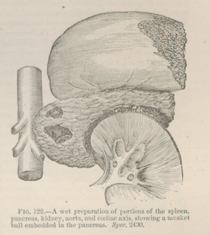Title: Koprieau, J.
Source text: The Medical and Surgical History of the War of the Rebellion. (1861-65.), Part 2, Volume 2 (Washington, DC: Government Printing Office, 1876), 159.
Civil War Washington ID: med.d2e31559
TEI/XML: med.d2e31559.xml
CASE 505.—Private J. Koprieau, Co. B, 51st New York, aged 32 years, was severely wounded at the battle of the Wilderness, May 5, 1864, and was at once taken to the field hospital of the 2nd division, Ninth Corps. The records of the hospital contain only the name and military description of the patient, with the entry "gunshot wounds of arm and hip." Searches through the held memoranda, and inquiries and medical officers under whose observation the case was likely to have fallen, have failed to procure any information respecting the early symptoms and progress of the case. As he could not speak English, and his attendants did not understand French, his own statement was not preserved. It can only be inferred that he had to undergo, with the other severely wounded of the Ninth Corps, the trying journey to Washington described in Medical Director McParlin's report, the Appendix to Part I. Arriving there, he was placed in Lincoln Hospital. Acting Assistant Surgeon E. L Bliss, the ward surgeon who treated the patient from May 25th, the day of his admission to Lincoln Hospital three weeks after the reception of the wound, until his death, gives the following information regarding the case, in a report to Assistant Surgeon J. C. McKee, which is here reproduced textually: "DOCTOR: I have the honor to report that Private J. Koprio, Co. B, 51st New York Regiment, on admission to my ward May 25, 1864, was found to be suffering from a gunshot wound of the back, received on May 5th, the ball having entered about six inches to the left of the spinal column and just below the eighth or ninth rib. Upon examination, it was discovered that the ball had entered the abdominal cavity, but its subsequent course I was unable to determine. Patient's general health was apparently good, and he seemed to suffer but little pain from the injury. Appetite good, bowels regular, urine slightly suppressed and somewhat highly colored. Pulse normally full, but slightly irritable. Ordered nourishing diet, with whiskey and quinine ter. die. Two moderate doses of potassæ acetas were administered, which was followed by a relief of the urinal suppression. No noticeable changes appeared for about one week, when a severe hæmorrhage occurred, apparently venous, from the external wound, which was soon suppressed by the use of compresses and styptics. About six hours afterward a quantity of urine was voided which was thickly mixed with blood. These hæmorrhages continued to recur two, three, and four times daily till death, the urinal discharge being very frequent and always bloody. Whiskey or brandy was administered every hour, more or less, as indicated, with an occasional dose of morphiæ sulphas; always enjoining the most perfect quiet and prescribing the most nutritious liquid diet." Death resulted June 5, 1864. A post-mortem examination was made by Acting Assistant Surgeon L. Schoney, which revealed the course of the ball as follows: "A minié ball entered at the middle portion of the eighth rib, fracturing the same, passed through the centre of the spleen toward the pancreas, penetrating this also in a nearly transverse direction, and (probably a few days before death) sinking toward the splenic artery, tearing it, and lodged at its origin from the cœliac axis; the lung was found emphysematous." The specimen, shown in the wood-cut (FIG. 122), was forwarded to the Museum by Assistant Surgeon J. Cooper McKee, U. S. A., and is a wet preparation, consisting of ports of the descending aorta and cœliac axis, spleen, pancreas, and left kidney. The ball has lodged in a pouch between the sloughing artery and vein.
